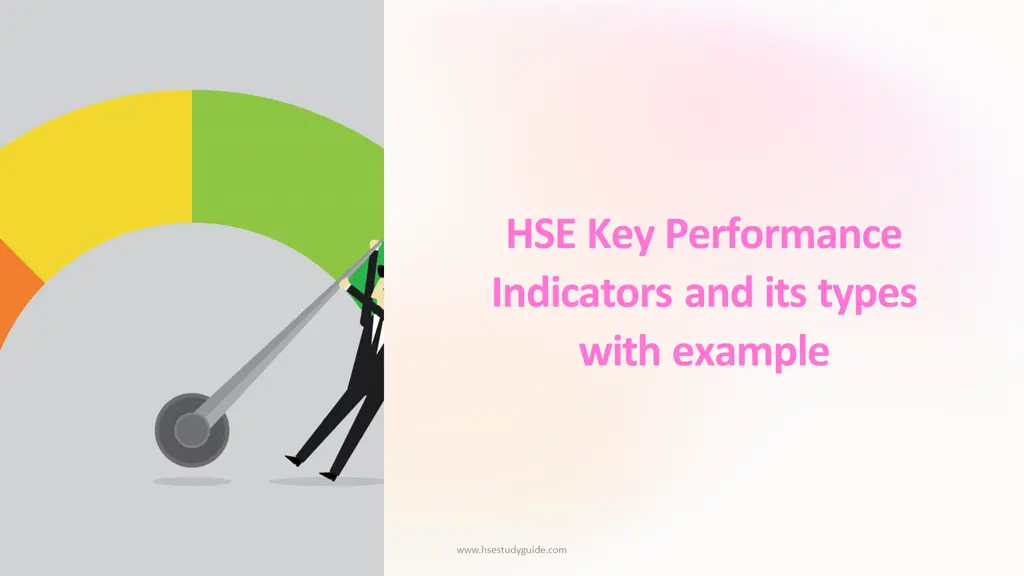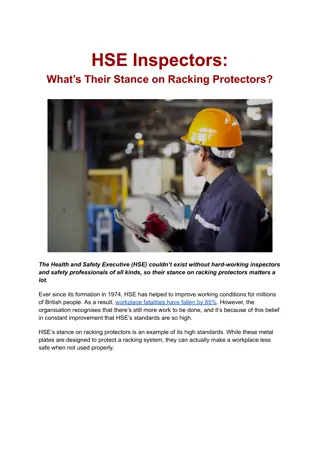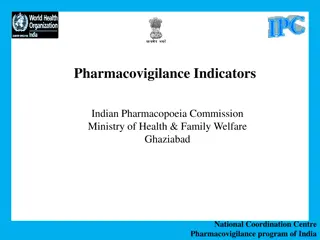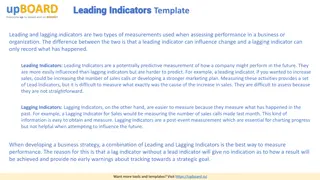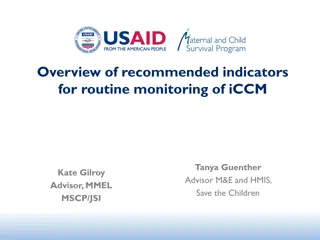HSE Key Performance Indicators and Their Types
Different types of HSE Key Performance Indicators (KPIs) that help evaluate performance, identify areas for improvement, and ensure safety compliance in an organization.
Download Presentation

Please find below an Image/Link to download the presentation.
The content on the website is provided AS IS for your information and personal use only. It may not be sold, licensed, or shared on other websites without obtaining consent from the author.If you encounter any issues during the download, it is possible that the publisher has removed the file from their server.
You are allowed to download the files provided on this website for personal or commercial use, subject to the condition that they are used lawfully. All files are the property of their respective owners.
The content on the website is provided AS IS for your information and personal use only. It may not be sold, licensed, or shared on other websites without obtaining consent from the author.
E N D
Presentation Transcript
HSE Key Performance Indicators and its types with example www.hsestudyguide.com
HSE Key Performance Indicators Health, Safety, and Environment (HSE) Key Performance Indicators (KPIs) are measurable values that demonstrate how effectively an organization is achieving its HSE objectives. These KPIs are essential for evaluating performance, identifying areas for improvement, and ensuring compliance with safety standards. They can be categorized into different types based on the aspects they measure: www.hsestudyguide.com
1) Leading Indicators KPIs: Safety Training Participation Rate:Measures the percentage of employees who have completed mandatory safety training within a specific period. Near Miss Reporting Rate:Calculates the number of reported near-miss incidents per month or year, reflecting proactive hazard identification. Safety Audit Compliance:Tracks the percentage of compliance with safety standards during internal safety audits or inspections. Safety Observation and Intervention Rate:Measures the frequency of safety observations made by employees and the subsequent interventions implemented. www.hsestudyguide.com
2) Lagging Indicators KPIs: Lost Time Injury Frequency Rate (LTIFR):Calculates the number of lost time injuries per million hours worked, indicating the severity of incidents. Total Recordable Incident Rate (TRIR):Measures the total number of work-related injuries, illnesses, and fatalities per hours worked. Days Away, Restricted, or Transferred (DART) Rate:Tracks the number of days away from work, restricted duties, or transferred due to workplace incidents. Environmental Compliance Index:Measures the organization's adherence to environmental regulations and standards. www.hsestudyguide.com
3) Compliance and Systems KPIs: Regulatory Compliance Rate:Evaluates the organization's compliance with HSE regulations and legal requirements. HSE Management System Audit Score:Assesses the effectiveness of the HSE management system through periodic audits and evaluations. Corrective Action Completion Rate:Tracks the percentage of completed corrective actions following incidents or safety audits. www.hsestudyguide.com
4) Behavioral KPIs: Safety Culture Surveys:Assesses employee perceptions, attitudes, and behaviors towards safety practices and the overall safety culture within the organization. Employee Participation in Safety Initiatives:Measures employee involvement in safety committees, safety programs, and suggesting safety improvements. www.hsestudyguide.com
Scenario: Construction Company Company XYZ www.hsestudyguide.com
1) Leading Indicator KPI -Safety Training Participation Rate: Objective:Company XYZ aims to enhance safety awareness among its workforce. KPI Description:Measure the percentage of employees who have completed mandatory safety training within a quarter. Sample Data:In Q3, out of 200 employees, 180 completed the safety training sessions. Calculation:Safety Training Participation Rate = (Number of Employees Completed Training / Total Number of Employees) x 100 Result:Safety Training Participation Rate for Q3 = (180/200) x 100 = 90% www.hsestudyguide.com
2) Lagging Indicator KPI -Lost Time Injury Frequency Rate (LTIFR): Objective:Company XYZ prioritizes reducing workplace injuries leading to lost work time. KPI Description:Calculate the number of lost time injuries per million hours worked. Sample Data:In Q3, there were 4 lost time injuries, and total hours worked by employees equaled 500,000 hours. Calculation:LTIFR = (Number of Lost Time Injuries / Total Hours Worked) x 1,000,000 Result:LTIFR for Q3 = (4 / 500,000) x 1,000,000 = 8 LTIs per million hours worked www.hsestudyguide.com
3) Compliance and Systems KPI -HSE Management System Audit Score: Objective:Assess the effectiveness of the HSE management system through audits. KPI Description:Evaluate the score achieved during the quarterly HSE management system audit on a scale of 0-100. Sample Data:In Q3 audit, Company XYZ scored 85 out of 100 in the HSE management system assessment. Result:HSE Management System Audit Score for Q3 = 85% www.hsestudyguide.com
4) Behavioral KPI -Safety Culture Surveys: Objective:Measure employee perceptions and attitudes towards safety practices. KPI Description:Conduct periodic safety culture surveys and rate on a scale of 1-5. Sample Data:Survey results show an average rating of 4.2 in Q3 on safety awareness and commitment. Result:Safety Culture Survey Score for Q3 = 4.2 out of 5 www.hsestudyguide.com
